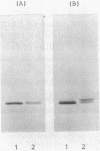Abstract
Computer graphics indicate that a steric hindrance exists between valine-110 side chain of human lysozyme (EC 3.2.1.17) and an acetyl group of a modified substrate that contains N6,O-diacetylmuramic acid. To alter the substrate specificity of human lysozyme to be effective on the modified substrate, we replaced the valine-110 residue with various amino acids by site-directed mutagenesis. One of the mutant proteins (valine residue replaced with proline:P110) was secreted in Saccharomyces cerevisiae as at least four components (P110-A, P110-B, P110-C, and P110-D) with different specific activities. Two components, P110-B and P110-D, were isolated in a pure form and structurally characterized. The results suggest that this mutation lowered the lytic activity against Micrococcus lysodeikticus by changing a local conformation of the catalytic site while keeping almost the same substrate binding sites. Our results also indicate that cis/trans isomerization of prolyl peptide bonds probably occurs in vivo and that the conformational change of protein as well as point mutations in genes might influence the molecular evolution of the protein.
Full text
PDF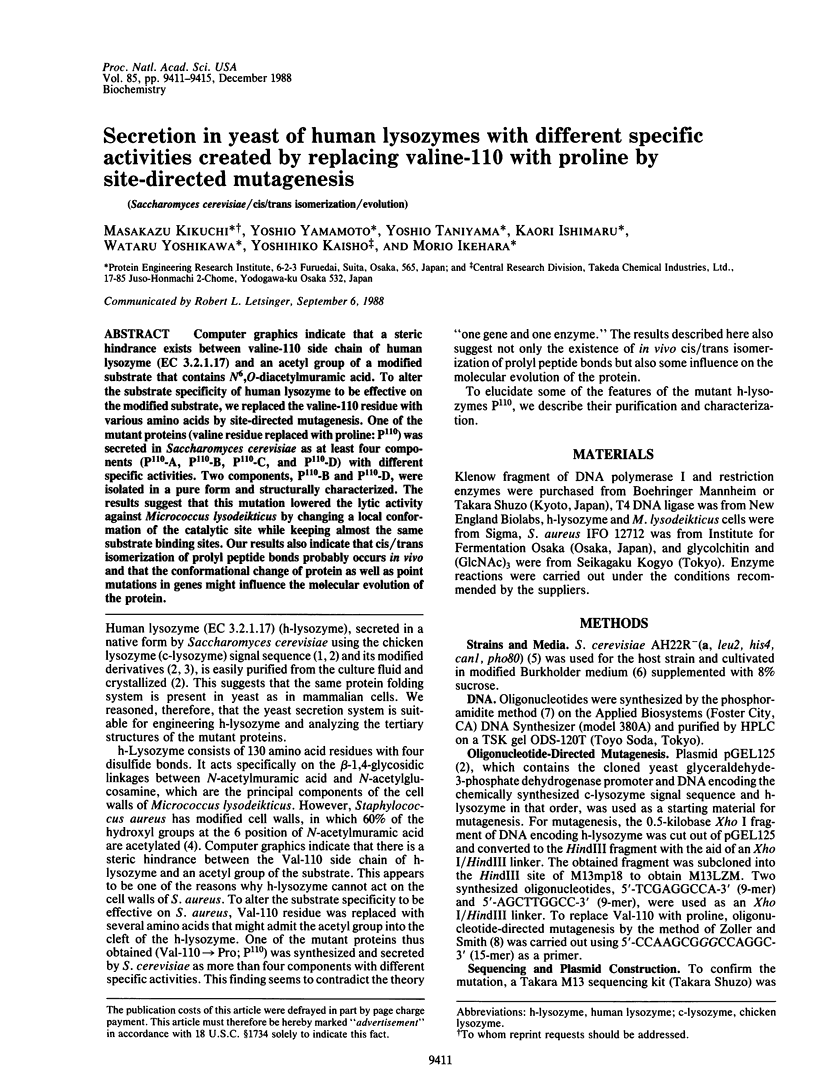
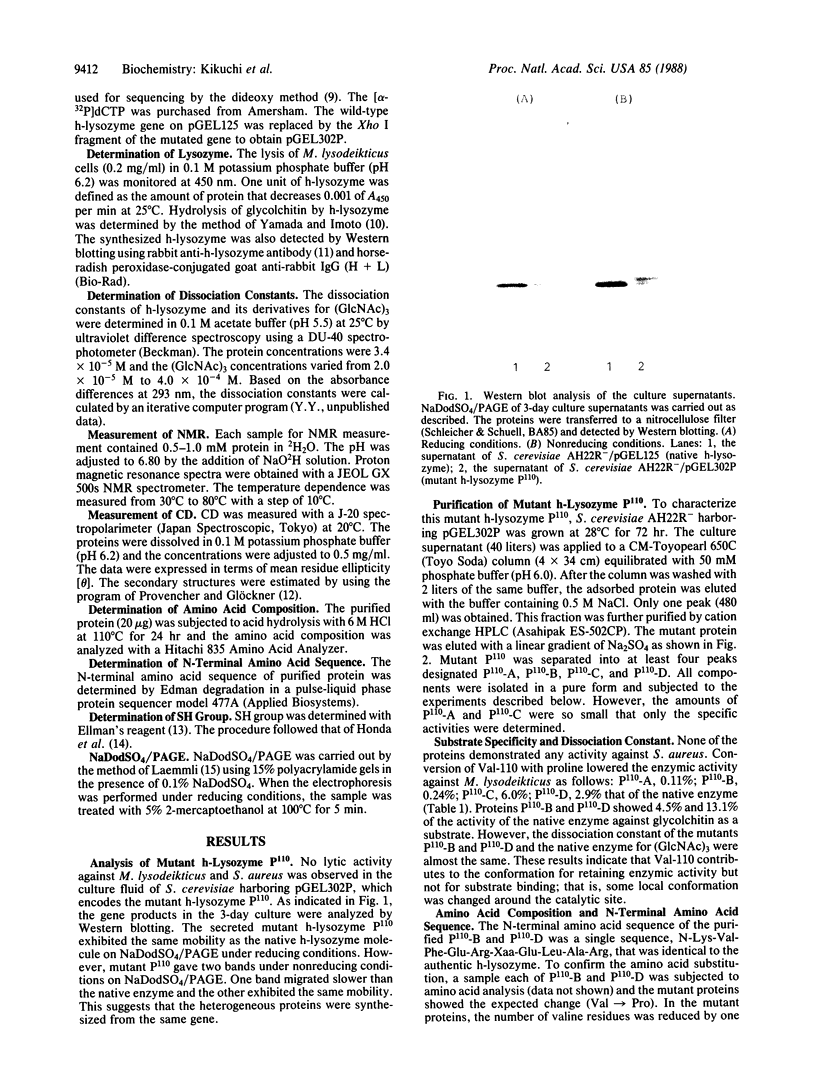
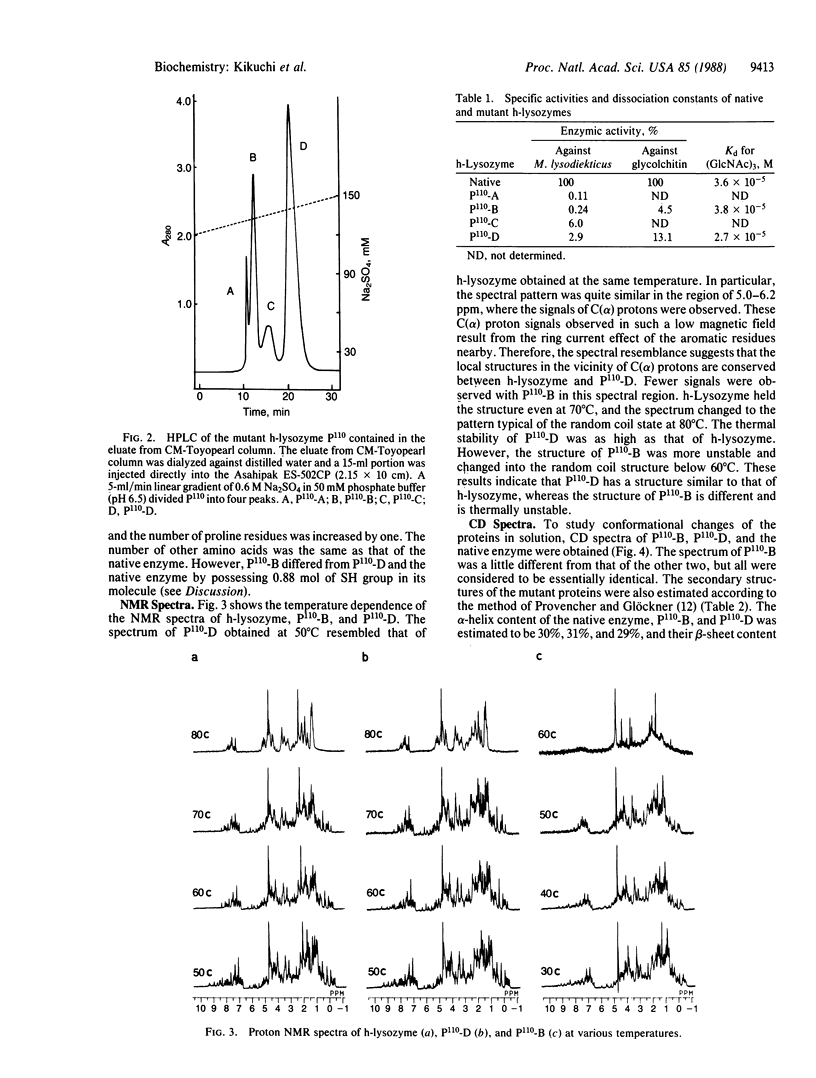
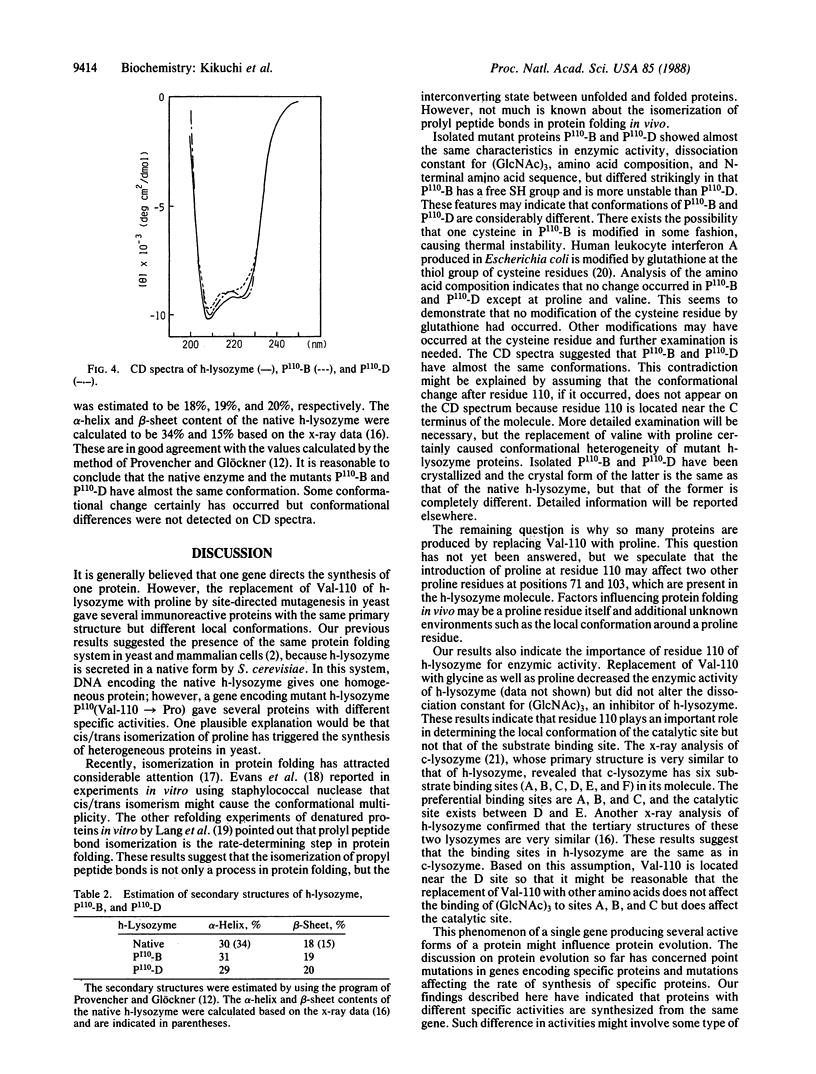
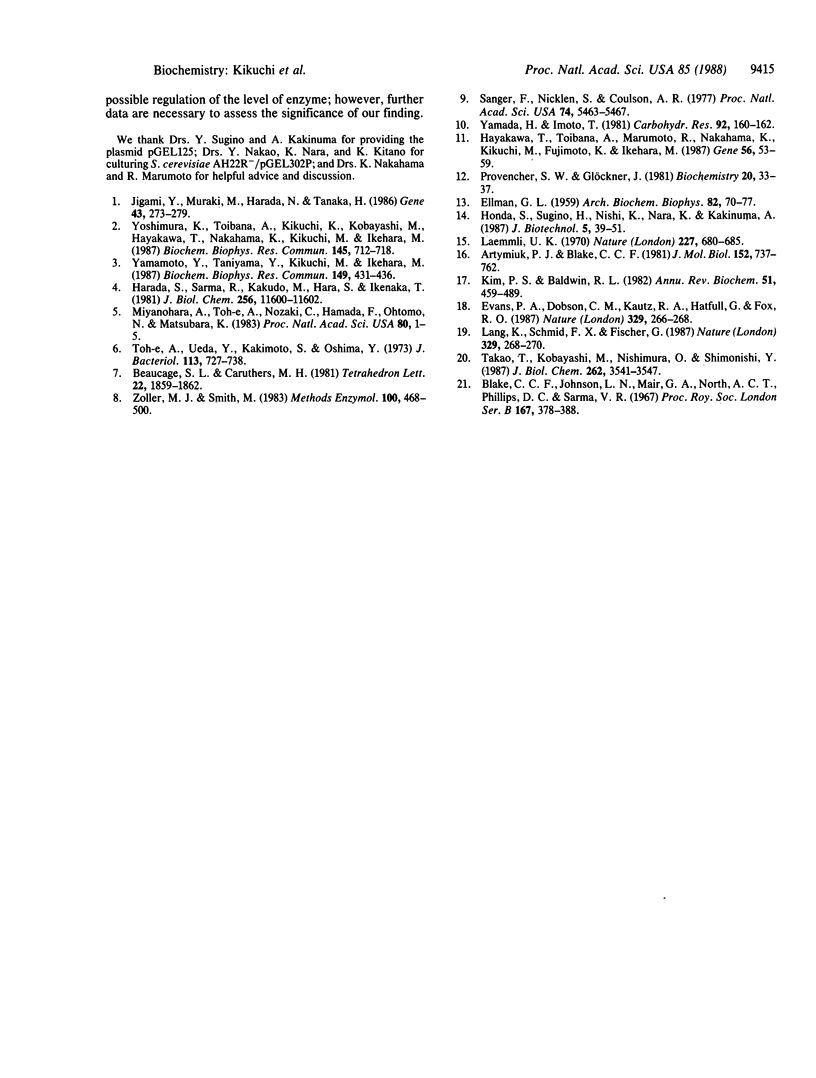
Images in this article
Selected References
These references are in PubMed. This may not be the complete list of references from this article.
- Artymiuk P. J., Blake C. C. Refinement of human lysozyme at 1.5 A resolution analysis of non-bonded and hydrogen-bond interactions. J Mol Biol. 1981 Nov 15;152(4):737–762. doi: 10.1016/0022-2836(81)90125-x. [DOI] [PubMed] [Google Scholar]
- Blake C. C., Johnson L. N., Mair G. A., North A. C., Phillips D. C., Sarma V. R. Crystallographic studies of the activity of hen egg-white lysozyme. Proc R Soc Lond B Biol Sci. 1967 Apr 18;167(1009):378–388. doi: 10.1098/rspb.1967.0035. [DOI] [PubMed] [Google Scholar]
- ELLMAN G. L. Tissue sulfhydryl groups. Arch Biochem Biophys. 1959 May;82(1):70–77. doi: 10.1016/0003-9861(59)90090-6. [DOI] [PubMed] [Google Scholar]
- Evans P. A., Dobson C. M., Kautz R. A., Hatfull G., Fox R. O. Proline isomerism in staphylococcal nuclease characterized by NMR and site-directed mutagenesis. Nature. 1987 Sep 17;329(6136):266–268. doi: 10.1038/329266a0. [DOI] [PubMed] [Google Scholar]
- Harada S., Sarma R., Kakudo M., Hara S., Ikenaka T. The three-dimensional structure of the lysozyme produced by Streptomyces erythraeus. J Biol Chem. 1981 Nov 25;256(22):11600–11602. [PubMed] [Google Scholar]
- Hayakawa T., Toibana A., Marumoto R., Nakahama K., Kikuchi M., Fujimoto K., Ikehara M. Expression of human lysozyme in an insoluble form in yeast. Gene. 1987;56(1):53–59. doi: 10.1016/0378-1119(87)90157-0. [DOI] [PubMed] [Google Scholar]
- Jigami Y., Muraki M., Harada N., Tanaka H. Expression of synthetic human-lysozyme gene in Saccharomyces cerevisiae: use of a synthetic chicken-lysozyme signal sequence for secretion and processing. Gene. 1986;43(3):273–279. doi: 10.1016/0378-1119(86)90216-7. [DOI] [PubMed] [Google Scholar]
- Kim P. S., Baldwin R. L. Specific intermediates in the folding reactions of small proteins and the mechanism of protein folding. Annu Rev Biochem. 1982;51:459–489. doi: 10.1146/annurev.bi.51.070182.002331. [DOI] [PubMed] [Google Scholar]
- Laemmli U. K. Cleavage of structural proteins during the assembly of the head of bacteriophage T4. Nature. 1970 Aug 15;227(5259):680–685. doi: 10.1038/227680a0. [DOI] [PubMed] [Google Scholar]
- Lang K., Schmid F. X., Fischer G. Catalysis of protein folding by prolyl isomerase. Nature. 1987 Sep 17;329(6136):268–270. doi: 10.1038/329268a0. [DOI] [PubMed] [Google Scholar]
- Provencher S. W., Glöckner J. Estimation of globular protein secondary structure from circular dichroism. Biochemistry. 1981 Jan 6;20(1):33–37. doi: 10.1021/bi00504a006. [DOI] [PubMed] [Google Scholar]
- Sanger F., Nicklen S., Coulson A. R. DNA sequencing with chain-terminating inhibitors. Proc Natl Acad Sci U S A. 1977 Dec;74(12):5463–5467. doi: 10.1073/pnas.74.12.5463. [DOI] [PMC free article] [PubMed] [Google Scholar]
- Takao T., Kobayashi M., Nishimura O., Shimonishi Y. Chemical characterization of recombinant human leukocyte interferon A using fast atom bombardment mass spectrometry. J Biol Chem. 1987 Mar 15;262(8):3541–3547. [PubMed] [Google Scholar]
- To-E A., Ueda Y., Kakimoto S. I., Oshima Y. Isolation and characterization of acid phosphatase mutants in Saccharomyces cerevisiae. J Bacteriol. 1973 Feb;113(2):727–738. doi: 10.1128/jb.113.2.727-738.1973. [DOI] [PMC free article] [PubMed] [Google Scholar]
- Yamada H., Imoto T. A convenient synthesis of glycolchitin, a substrate of lysozyme. Carbohydr Res. 1981 May 18;92(1):160–162. doi: 10.1016/s0008-6215(00)85993-5. [DOI] [PubMed] [Google Scholar]
- Yamamoto Y., Taniyama Y., Kikuchi M., Ikehara M. Engineering of the hydrophobic segment of the signal sequence for efficient secretion of human lysozyme by Saccharomyces cerevisiae. Biochem Biophys Res Commun. 1987 Dec 16;149(2):431–436. doi: 10.1016/0006-291x(87)90385-8. [DOI] [PubMed] [Google Scholar]
- Yoshimura K., Toibana A., Kikuchi K., Kobayashi M., Hayakawa T., Nakahama K., Kikuchi M., Ikehara M. Differences between Saccharomyces cerevisiae and Bacillus subtilis in secretion of human lysozyme. Biochem Biophys Res Commun. 1987 Jun 15;145(2):712–718. doi: 10.1016/0006-291x(87)91023-0. [DOI] [PubMed] [Google Scholar]
- Zoller M. J., Smith M. Oligonucleotide-directed mutagenesis of DNA fragments cloned into M13 vectors. Methods Enzymol. 1983;100:468–500. doi: 10.1016/0076-6879(83)00074-9. [DOI] [PubMed] [Google Scholar]



